Drought Tolerant Iris
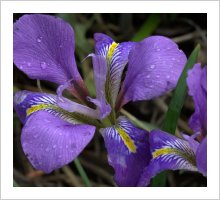 There can hardly be a more useful, more obliging perennial than the winter flowering Iris unguicularis which starts to bloom in May and carries on its display well into September. The clone most commonly found in gardens is known throughout the horticultural world as The Algerian Iris. It makes a tussock of arching, dark green leathery leaves, 1cm wide by 60cm long. Large lilac flowers nestle in the foliage. If gently pulled whilst in pencil, that is just before they open, the flowers will last four or five days in a vase filling the room with a delicious primrose fragrance as they unfurl.
There can hardly be a more useful, more obliging perennial than the winter flowering Iris unguicularis which starts to bloom in May and carries on its display well into September. The clone most commonly found in gardens is known throughout the horticultural world as The Algerian Iris. It makes a tussock of arching, dark green leathery leaves, 1cm wide by 60cm long. Large lilac flowers nestle in the foliage. If gently pulled whilst in pencil, that is just before they open, the flowers will last four or five days in a vase filling the room with a delicious primrose fragrance as they unfurl.
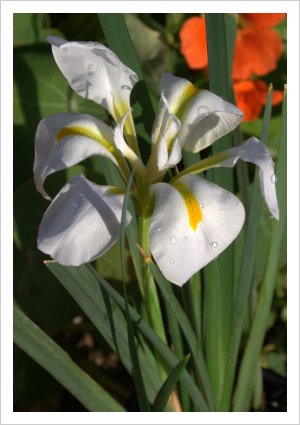 There are a few different forms of Iris unguicularis ‘Alba’. I grow a really good one which should perhaps be given a distinguishing name as it is so much better than the older, thin petalled, rather pinched looking white selections. I raised my clone from seed about twenty years ago. It has large creamy white flowers with lovely yellow markings on the falls.
There are a few different forms of Iris unguicularis ‘Alba’. I grow a really good one which should perhaps be given a distinguishing name as it is so much better than the older, thin petalled, rather pinched looking white selections. I raised my clone from seed about twenty years ago. It has large creamy white flowers with lovely yellow markings on the falls.
I.‘Mary Barnard’, collected in 1937 near Algiers is a very good doer with large, dark violet flowers beautifully marked with contrasting gold lines on the falls.
A variety which is sometimes available is I. u. ‘Variegata’ with darker mottling and streaking on the lilac flower. This mottling is more than likely caused by virus disease and is not in any way attractive.
Iris unguicularis not only grows in Algeria and Tunisia but also in Greece, Crete, Rhodes, Turkey, Syria and Lebanon.
Three years ago Marcus Harvey (www.hillviewrareplants.com ) sent me seeds of Iris unguicularis ssp cretensis which he had collected on the Mani peninsula in the Peleponese. The seed germinated well and when the plants were big enough I planted a drift of two hundred or so under a row of Mt Fuji flowering cherries.
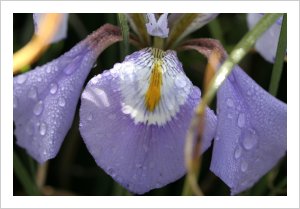 Only a handful of the seedlings bloomed last year but this season every plant is flowering. Whilst there is quite a range of flower colour, from soft lilac to deep violet, it’s the markings on the falls which vary the most. Every plant has a different patterning, some have bold white brush strokes, some have faint white markings between violet veins and others have rings of white and lilac. All have gold and violet guide lines to help pollinators find the style and stigma. The standards of these Iris are almost as large as the falls and all have a striking a gold-bronze haft. Arching, narrow dark green leaves are about 40cm long and the flower stem is 30cm tall.
Only a handful of the seedlings bloomed last year but this season every plant is flowering. Whilst there is quite a range of flower colour, from soft lilac to deep violet, it’s the markings on the falls which vary the most. Every plant has a different patterning, some have bold white brush strokes, some have faint white markings between violet veins and others have rings of white and lilac. All have gold and violet guide lines to help pollinators find the style and stigma. The standards of these Iris are almost as large as the falls and all have a striking a gold-bronze haft. Arching, narrow dark green leaves are about 40cm long and the flower stem is 30cm tall.
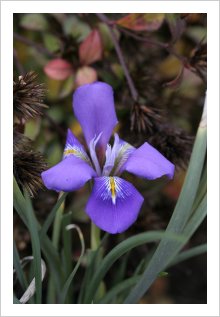 Iris cretensis ‘Mia’ is a plant I selected from a batch of seedlings grown from a 1984 collection that Jim and Jenny Archibald made in Messinia in the hills above Pilos in the Peleponese. ‘Mia’ is a compact plant with 20cm tall, upright leaves. The dark violet-blue flowers are relatively small but are displayed well. It does best in a sunny spot and is small and neat enough for a rock garden.
Iris cretensis ‘Mia’ is a plant I selected from a batch of seedlings grown from a 1984 collection that Jim and Jenny Archibald made in Messinia in the hills above Pilos in the Peleponese. ‘Mia’ is a compact plant with 20cm tall, upright leaves. The dark violet-blue flowers are relatively small but are displayed well. It does best in a sunny spot and is small and neat enough for a rock garden.
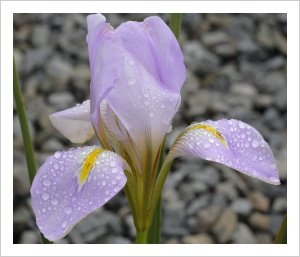 Similar in size is I. cretensis ‘Starker’s Pink’ which has attractive lilac-pink flowers. I got it Iris cretensis 'Starker's Pink' thirty years ago from Ken Gillanders who ran Woodbank Nursery in Tasmania at the time. Sadly ‘Starker’s Pink’ isn’t a vigorous plant but it is so beautiful that it’s worth every effort to make it happy. In my garden it does best in a sunny well drained spot which has been fenced off against rabbits. Rabbits will graze this Iris to death if given half a chance.
Similar in size is I. cretensis ‘Starker’s Pink’ which has attractive lilac-pink flowers. I got it Iris cretensis 'Starker's Pink' thirty years ago from Ken Gillanders who ran Woodbank Nursery in Tasmania at the time. Sadly ‘Starker’s Pink’ isn’t a vigorous plant but it is so beautiful that it’s worth every effort to make it happy. In my garden it does best in a sunny well drained spot which has been fenced off against rabbits. Rabbits will graze this Iris to death if given half a chance.
None of the I. u. cretensis clones I grow are fragrant, although when brought inside a faint whiff of honey can be detected.
Lambley Nursery has four varieties of Iris unguicularis listed on the web catalogue.